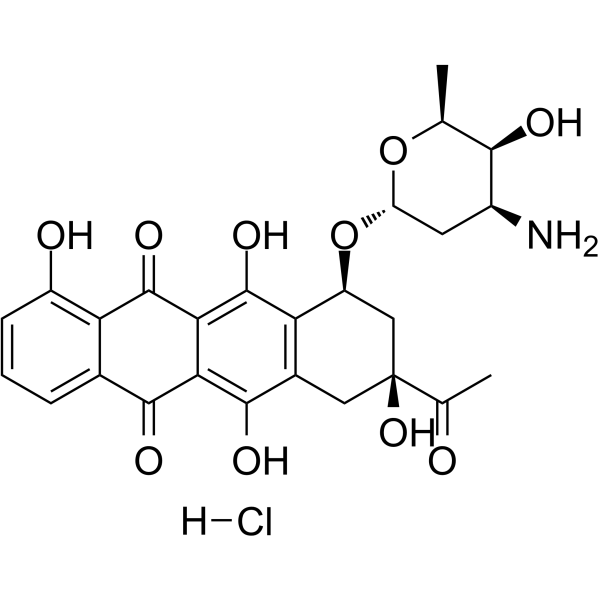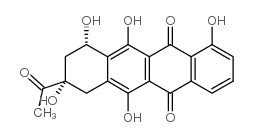52794-97-5
| Name | Karminomycin hydrochloride |
|---|---|
| Synonyms |
Carubicin Hydrochloride
5,12-Naphthacenedione, 8-acetyl-10-[(3-amino-2,3,6-trideoxy-α-L-lyxo-hexopyranosyl)oxy]-7,8,9,10-tetrahydro-1,6,8,11-tetrahydroxy-, (8S,10S)-, hydrochloride (1:1) (1S,3S)-3-Acetyl-3,5,10,12-tetrahydroxy-6,11-dioxo-1,2,3,4,6,11-hexahydro-1-tetracenyl 3-amino-2,3,6-trideoxy-α-L-lyxo-hexopyranoside hydrochloride (1:1) Carminomycin hydrochloride (1S,3S)-3-Acetyl-1,2,3,4,6,11-hexahydro-3,5,10,12-tetrahydroxy-6,11-dioxo-1-naphthacenyl 3-amino-2,3,6-trideoxy-α-L-lyxo-hexopyranoside hydrochloride Karminomycin hydrochloride Caminomycin hydrochloride 5,12-Naphthacenedione, 8-acetyl-10-((3-amino-2,3,6-trideoxy-α-L-lyxo-hexopyranosyl)oxy)-7,8,9,10-tetrahydro-1,6,8,11-tetrahydroxy-, hydrochloride, (8S-cis)- |
| Description | Carubicin hydrochloride is a microbially-derived compound. Carubicin hydrochloride is an effective inhibitor of VHL-defective (VHL−/−) CCRCC cell proliferation. Carubicin hydrochloride also induces apoptosis by a mechanism independent of p53 or hypoxia-inducible factor HIF2. Carubicin hydrochloride has the potential for the research of cancer diseases[1][2]. |
|---|---|
| Related Catalog | |
| References |
| Density | 1.63g/cm3 |
|---|---|
| Boiling Point | 750.6ºC at 760mmHg |
| Molecular Formula | C26H28ClNO10 |
| Molecular Weight | 549.954 |
| Flash Point | 407.7ºC |
| Exact Mass | 549.140198 |
| PSA | 196.84000 |
| LogP | 2.22820 |
CHEMICAL IDENTIFICATION
HEALTH HAZARD DATAACUTE TOXICITY DATA
MUTATION DATA
|
| Precursor 0 | |
|---|---|
| DownStream 1 | |

